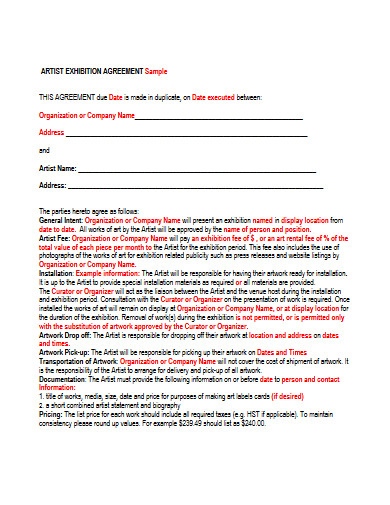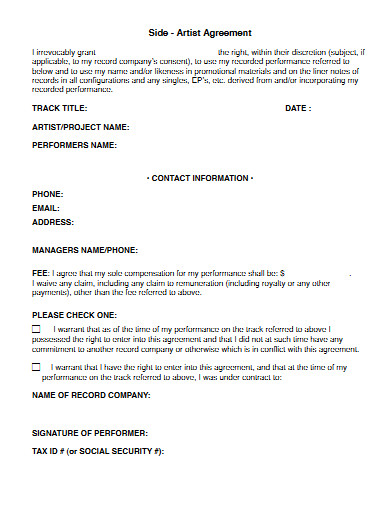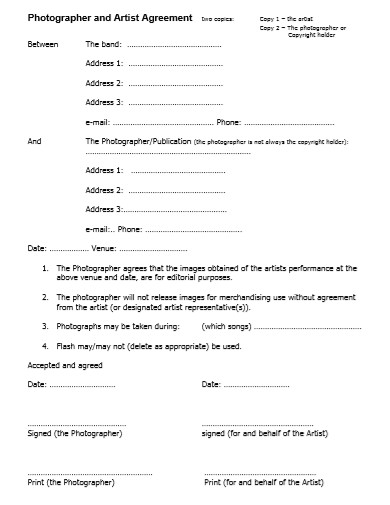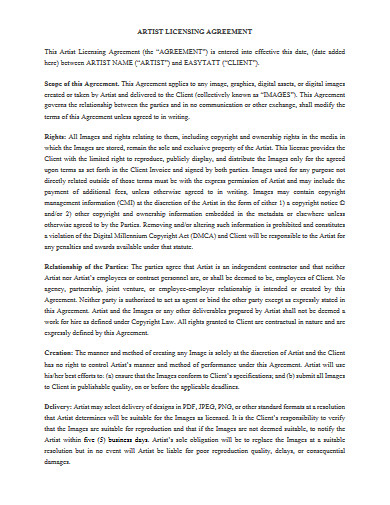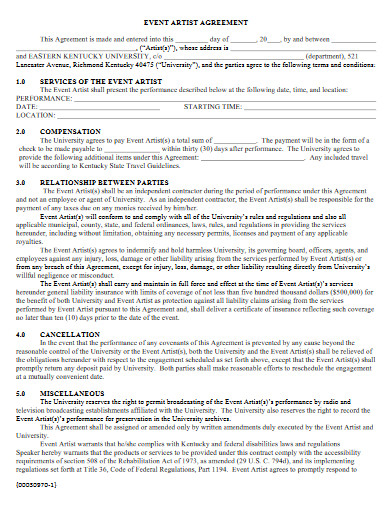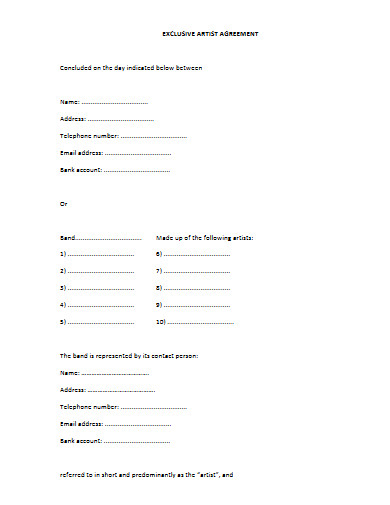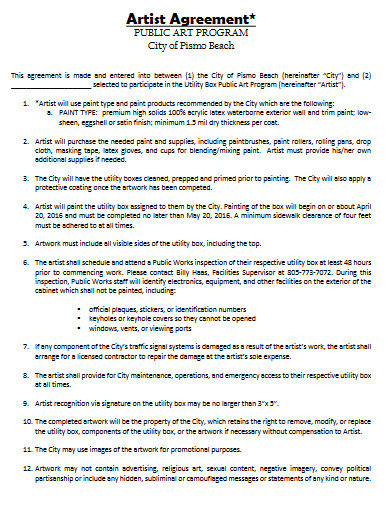10+ Artist Agreement Examples to Download
As an artist, your work demands a significant amount of your time and talent to perform your job. Whether you’re recording for a producer, modeling for a makeup artist, or painting a mural for an establishment, it’s always best to safeguard your transactions and ensure that you’ll receive what you’re due. Accomplish that with an artist agreement. This helps you clarify your terms with a client and to bind them to legal responsibility. This prompts both parties to discuss the situation thoroughly and to act accordion to the content of the document. Read the article below to find out more.
10+ Artist Agreement Examples
1. Artist Agreement Template
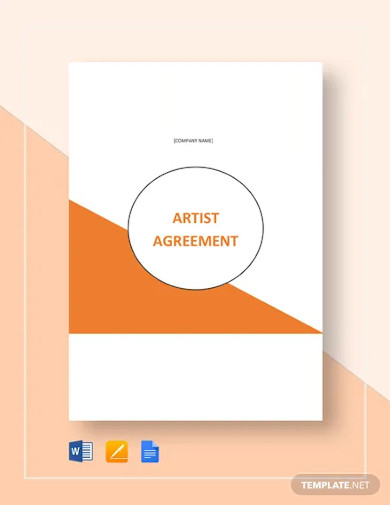
2. Artist Agent Agreement Template

3. Sample Artist Performance Agreement
4. Artist Exhibition Agreement
5. Exclusive Artist Agreement
6. Side Artist Agreement
7. Photographer and Artist Agreement
8. Artist Licensing Agreement
9. Event Artist Agreement
10. Exclusive Artist Agreement Example
11. Artist Agreement in PDF
What Is an Artist Agreement?
An artist agreement is a legal document between a client and an artist regarding a booking, performance, commission, and other pertinent activities. This outlines both parties’ duties in fulfilling the agreement and the results they both expect from the engagement. While legal documents such as this may sound intimidating, it’s actually a simple copy of responsibilities and the agreed terms to clarify the scope of work and other relevant agreement clauses to avoid complications.
How Agreements and Contracts Protects Artists
If you’re a social media artist who does freelance work on the sideline, then your client request must have only existed on your Instagram chat walls and never on a legal contract. Why not? Well, it’s a hassle, and it can be lengthy. Plus, you don’t know any legal terms. Besides, why bother with a contract when you can fulfill the request, ship the illustration, and receive the money? Easy-peasy. These are among the misconceptions when it comes to agreements and contracts, and you’re not alone in thinking about this.
But why should you have a reliable agreement and contract?
According to Artstation Magazine’s comprehensive artist’s contract guide, among the reasons why artists need a contract because it’s your safeguard against clients with ill intentions. Showing your email conversations may not provide the right details when they decide to scam you. Your client’s signature on the agreement is concrete proof that they’re responsible for following the terms, and failing to do so means legal consequences. If you insist on refusing to draft legal documents because you are careful, you are allowing yourself to be open to fraud and trickery.
How to Make an Artist Agreement
If you’re unsure of how you’ll begin writing your artist agreement, here are some guidelines that you can follow:
1. Identify the Parties
Your agreement should provide clear identification of the parties involved in the signing. Include the client and the artist’s name, business, contact number, and email. Specifying this information makes it easy to identify the different participating roles of the contract for review. This also makes them reachable because signing an artist contract requires constant communication with those who are involved. When complications arise amidst the duration of the contract, this information makes it easy to identify who’s accountable if mistakes or agreement breach happens.
2. Describe the Agreement Terms
An artist agreement varies according to the kind of artists involved and the services or projects they’re going to perform or deliver. This clause should detail the roles and duties of the artist and his or her client. This is the highlight of the agreement because this will explain why there’s an agreement in the first place. If it’s an artist performance contract for a musical event, this should explain the details of the act. If it’s an art commission contract for an artwork gallery, this should include the description of the work, who will be responsible for the shipment, and what consequences await if there are damages to the painting or any artwork.
3. Specify the Timeline
Aside from providing accurate details of the agreement’s terms, don’t forget to specify details about the agreement’s timeline. This will serve as the basis for when the contract will start and when it will end. It’s important to note that you should avoid including vague timeline lengths. Words such as “a month,” “a year,” or even “two weeks after contract signing” have no place in your agreement. Mention the exact dates, whether it’s a long term job or a short appointment schedule. If you’re unsure about this, you can include a disclaimer that the project’s length depends on certain factors and might require an extension.
4. Include Payment Terms
Never trust an artist agreement that doesn’t say anything about compensations. This is an essential part of the document is something that needs a spotlight during the agreement discussion. Include all possible monetary transactions involved in the activity, including taxes and miscellaneous fees. State which expenses the client will shoulder and which are those that are within the artist’s responsibilities. You would also want to have a payment schedule to avoid delays. The payment term is a crucial matter in contracts and agreements because it’s a constant source of complications. Whether you’re the artist or the client, a monetary dispute can potentially ruin your reputation.
FAQs
What are some of the things that you should include in your artist agreement?
The important parts of an artist agreement include:
- Client details
- Project details
- Schedule
- Payment information
- Item list (for artworks)
- Rights of the artist
- Cancellation
What are some examples of the types of artist contracts?
Some examples of the types of contracts are art consignment agreement, art licensing agreement, and commission agreements.
Do you need a lawyer for your artist agreement?
Lawyers are optional when making or reviewing contracts. They can be pricey, but if you want to ensure that you’ll miss nothing, you can do so.
As an artist, your job is your passion. It’s necessary to protect not only your business transactions but also the talent and effort you spend on every single assignment. This is why you must have an artist’s agreement with you. This way, you can be sure that you’ll receive the agreed compensation and terms. We understand that it can be a hassle, so we provide you with a wide array of agreement template options for your work. They’re all ready-made in premium quality. Download now!




